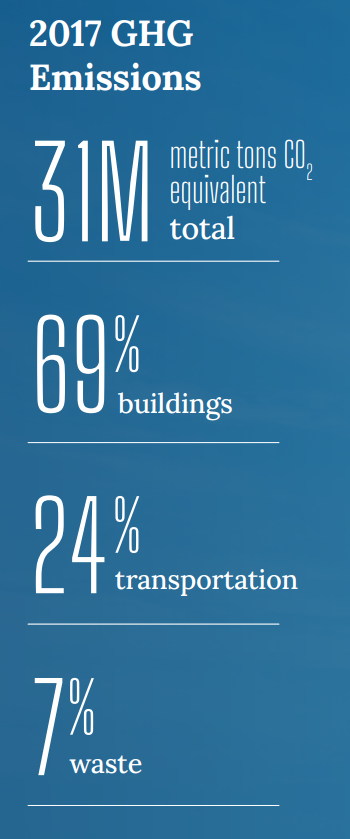Electrify Chicago
An independent tool for viewing City of Chicago building data
According to the
2022 Chicago Climate Action Plan,
69% of Chicago's emissions come from buildings, making
building emissions our biggest challenge and our biggest opportunity as a city
to tackle climate change. At Electrify Chicago, we showcase building performance using
publicly available data supplemented by community-submitted photographs and building
owners.
Start by looking at Chicago's buildings with the highest greenhouse gas intensity i.e. emissions per square foot. Large, efficient, buildings can perform much better than very inefficient small buildings on this metric.
New Article
📰 $30 Million In Missed Fines
The City Of Chicago failed to collect $30 million in potential fines from the building benchmarking ordinance, reducing transparency and accountability.
Legislative update! 🎉
As of late January 2024, legislation is being introduced to require new use more efficient forms of water and space heating, via the Clean And Affordable Buildings Ordinance (CABO), which will reduce the number of highly polluting and inefficient buildings that end up on this site.
If you're in Chicago,
write to your alderman to support the CABO!
Chicago Buildings by Greenhouse Gas Intensity
Note: Data includes large Chicago buildings with data from 2022, unless explicitly stated otherwise.
Note: This data only includes buildings whose emissions are reported
under the
Chicago Energy Benchmarking Ordinance. According to the City “As of 2016,
this list includes all commercial, institutional, and residential buildings larger than
50,000 square feet.” This dataset is also then filtered to only buildings with
reported emissions > 1,000 metric tons CO2 equivalent.
The latest year of data is from 2022, but we update the site regularly when new data is available, and some buildings may have failed to report that year, and only have older data available.
| Property Name / address | Primary Property Type |
Greenhouse Gas Intensity (kg CO2 eq./sqft) |
Total Greenhouse Emissions (metric tons CO2 eq.) |
|---|---|---|---|
|
2620 W WASHINGTON BLVD
2620 W WASHINGTON BLVD
| Multifamily Housing | 5.8 kg/sqft
Lowest 39%
| 425 tons
Lowest 19%
|
|
56th & Kimbark Condominium Association
5543 5559 S KIMBARK AVE
| Multifamily Housing | 5.8 kg/sqft
Lowest 39%
| 361 tons
Lowest 14%
|
|
1335 1343 N ASTOR ST
1335 1343 N ASTOR ST
| Multifamily Housing | 5.8 kg/sqft
Lowest 39%
| 638 tons
Lowest 36%
|
|
1509 1521 W MORSE AVE
1509 1521 W MORSE AVE
| Multifamily Housing | 5.8 kg/sqft
Lowest 39%
| 359 tons
Lowest 13%
|
|
447 457 W WELLINGTON AVE
447 457 W WELLINGTON AVE
| Multifamily Housing | 5.8 kg/sqft
Lowest 39%
| 298 tons
Lowest 8%
|
|
625 N Michigan Ave
625 N Michigan Ave
| Office | 5.8 kg/sqft
Lowest 39%
| 2,096 tons
Highest 22%
|
|
20 N Clark St
20 N Clark St
| Office | 5.8 kg/sqft
Lowest 39%
| 2,571 tons
Highest 17%
|
|
224 S Michigan Ave
224 S Michigan Ave
| Office | 5.8 kg/sqft
Lowest 39%
| 2,396 tons
Highest 19%
|
|
IL0000FC-CHICAGO FEDERAL CTR
🕰️
219 S Dearborn
| Mixed Use Property | 5.8 kg/sqft | 18,420 tons |
|
Tribune Tower
435 N Michigan Ave
| Multifamily Housing | 5.8 kg/sqft
Lowest 39%
| 5,172 tons
Highest 7%
|
|
O'Hare Plaza I
8725- 8745 W Higgins Rd
| Office | 5.8 kg/sqft
Lowest 39%
| 3,098 tons
Highest 13%
|
|
Congress Center
525 W Van Buren
| Office | 5.8 kg/sqft
Lowest 39%
| 3,053 tons
Highest 14%
|
|
754 S WABASH AVE
754 S WABASH AVE
| College/University | 5.7 kg/sqft
Lowest 37%
| 700 tons
Lowest 40%
|
|
The Jax
1220 W. Jackson Blvd
| Multifamily Housing | 5.7 kg/sqft
Lowest 37%
| 740 tons
Lowest 43%
|
|
River Walk Townhomes
2903-2923 N Claremont Ave
| Multifamily Housing | 5.7 kg/sqft
Lowest 37%
| 406 tons
Lowest 17%
|
Data Source:
Chicago Energy Benchmarking Data
